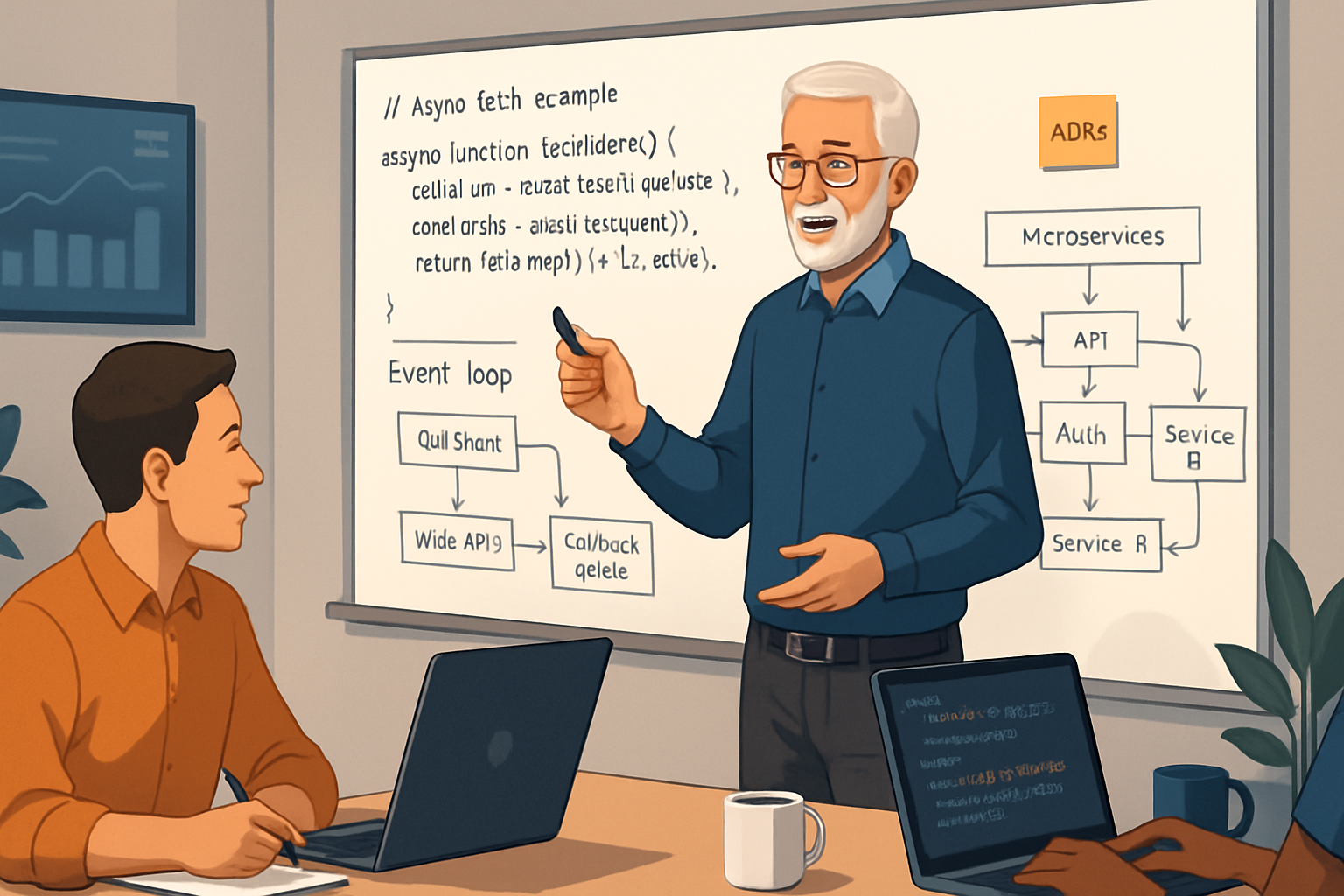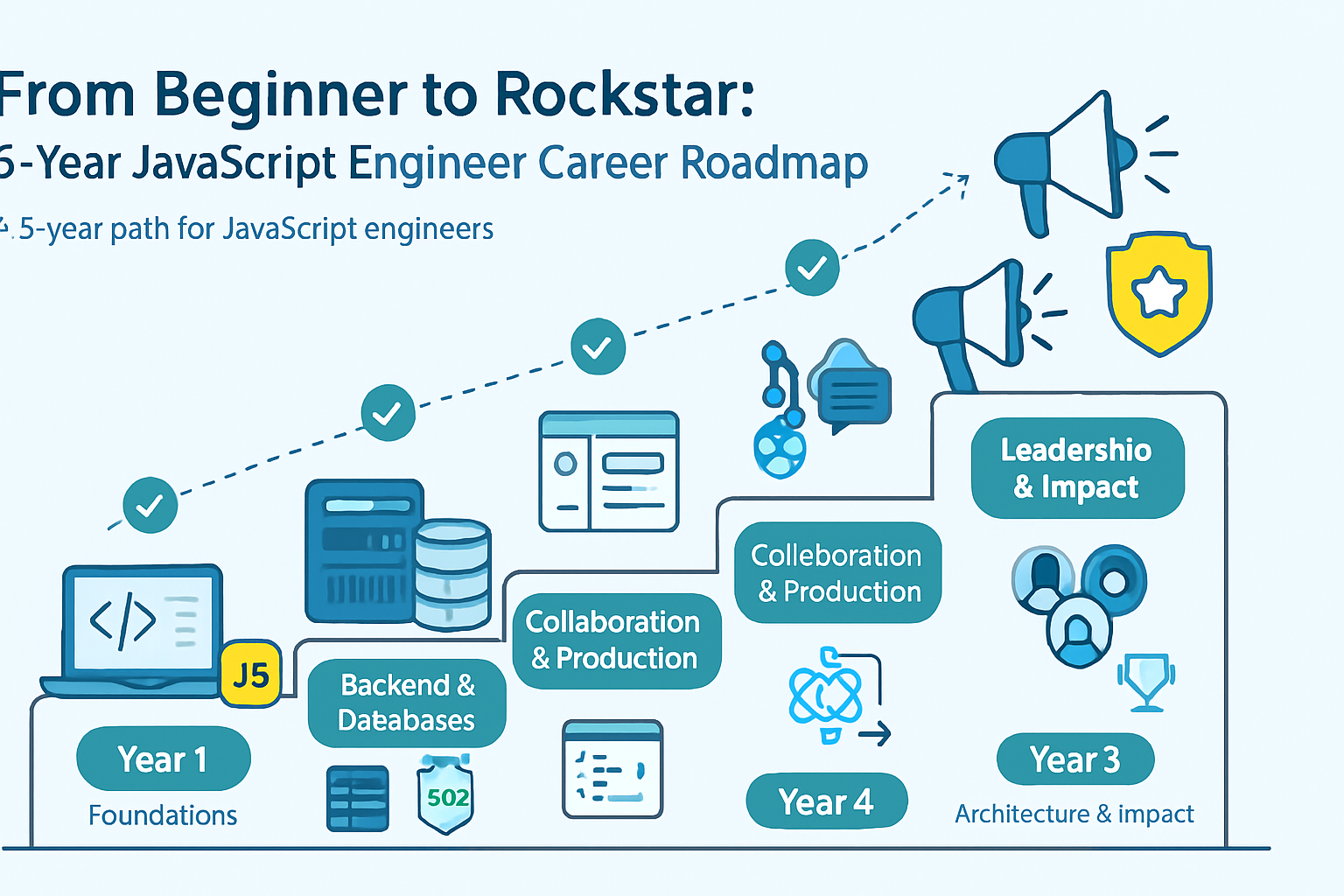· career · 5 min read
Your Path to Tech Leadership: Skills Every JavaScript Developer Must Master
A practical guide for JavaScript developers who want to step into tech leadership - technical foundations, soft skills, and a 90-day action plan to get there.

Why become a tech lead (and what it actually means)
Moving from senior developer to tech lead is more than a title change - it’s a shift in scope. A tech lead still writes code, but their impact is amplified through architecture decisions, team enablement, and cross-functional collaboration. Success is measured less by lines of code and more by the team’s ability to deliver reliable, maintainable value.
This guide walks through the technical and interpersonal skills you need to master, with practical steps and resources.
The core mindset: from individual contributor to multiplier
Tech leads are multipliers. Your goal is to increase the throughput, quality, and confidence of the people and systems around you. That means balancing:
- Strategic thinking (roadmaps, architecture, technical debt) with tactical execution (PRs, incidents).
- Ownership of long-term quality (design, observability) with fast feedback loops (CI/CD, testing).
- Coaching and conflict resolution with clear communication to stakeholders.
Essential technical skills
1) System & code architecture
You must be able to design systems that scale, are maintainable, and align with business needs.
Focus areas:
- Decomposition: split monoliths into bounded contexts and modules, not just microservices for the sake of it.
- Contracts and API design: stable, versioned APIs with clear error semantics.
- Data modeling and consistency: choose patterns (eventual vs strong consistency) based on use-case.
- Layers and separation of concerns: UI, business logic, persistence, infrastructure.
Resources:
- Martin Fowler on architecture patterns: https://martinfowler.com/
- Uncle Bob on clean architecture: https://8thlight.com/blog/uncle-bob/2012/08/13/the-clean-architecture.html
2) Modern JavaScript & TypeScript mastery
A tech lead should be the team’s JavaScript authority:
- Deep knowledge of ESNext features and runtime environments (browsers, Node.js).
- Strong TypeScript skills to reduce runtime errors and improve collaboration through types.
- Module systems, bundlers, tree-shaking, and code-splitting for web performance.
References:
- MDN JavaScript docs: https://developer.mozilla.org/en-US/docs/Web/JavaScript
- TypeScript: https://www.typescriptlang.org/
3) Testing and quality gates
Ensure confidence through automated testing and quality checks.
- Testing pyramid: unit → integration → end-to-end (focus where value is highest).
- Use test doubles wisely and keep e2e tests focused on critical flows.
- Enforce linting, type checks, and static analysis in the CI pipeline.
Tools and guidance:
- Jest: https://jestjs.io/
- Testing Library: https://testing-library.com/
4) CI/CD, release strategy, and deployments
Reliable delivery is a leadership responsibility.
- Implement fast, safe pipelines: build → test → deploy with clear rollback strategies.
- Use feature flags for safe releases and progressive rollouts.
- Automate deployments, but keep manual guardrails for risky operations.
Good reading:
- GitHub flow & trunk-based development articles: https://trunkbaseddevelopment.com/
- DORA research and “Accelerate”: https://cloud.google.com/solutions/devops/devops-reference
5) Observability and incident response
Design systems so you can understand and fix them quickly.
- Telemetry triad: metrics, logs, traces.
- SLOs/SLIs and alerting that focus on user impact, not noisy signals.
- Postmortems that are blameless and lead to corrective action.
Authoritative sources:
- Google SRE book (on SLOs & incident response): https://sre.google/books/
6) Security and performance
- Follow OWASP guidance for web security: https://owasp.org/
- Enforce secure defaults, dependency scanning, and threat modeling early.
- Performance budgets, code-splitting, and critical rendering path optimization for front-end teams.
Essential soft skills
Technical credibility gets you the seat at the table; soft skills let you stay and lead effectively.
1) Effective communication
- Be concise and structured - explain tradeoffs, assumptions, and recommended actions.
- Translate technical implications into business outcomes for stakeholders.
- Document decisions: ADRs (Architecture Decision Records) make tradeoffs visible.
Read about ADRs: https://www.martinfowler.com/articles/architecture-decision-records.html
2) Coaching and mentorship
- Regular 1:1s with direct reports focused on growth over status.
- Teach by example (pair programming, live design sessions) and by delegation (assign ownership with support).
- Provide feedback that is timely, specific, and actionable.
Recommended book: Camille Fournier - “The Manager’s Path” (https://www.manning.com/books/the-managers-path)
3) Leading through influence
You will often need to persuade other teams, product managers, and engineers without direct authority.
- Build trust through competence, consistency, and follow-through.
- Use data and prototypes to make abstract ideas concrete.
4) Team dynamics and hiring
- Recognize healthy team patterns: psychological safety, shared goals, clear responsibilities.
- Hire for growth potential and cultural add; structure interviews to evaluate problem-solving, communication, and system thinking.
- Onboarding: design a track that makes new hires productive and connected fast.
Team Topologies for team design: https://teamtopologies.com/
5) Prioritization and roadmap trade-offs
- Learn to prioritize technical debt, new features, and operational work with product and stakeholders.
- Use lightweight frameworks (e.g., RICE, ICE) and time-boxing to make decisions.
Practical checklists and examples
Code review checklist (short)
- Does the change have a clear purpose and linked ticket?
- Are tests added/updated for new behavior?
- Does it maintain invariants and handle edge cases?
- Is the public API stable and well-documented?
- Are performance/security implications considered?
- Can the change be rolled back safely?
Architecture decision record (minimal template)
- Title
- Context (what problem)
- Decision (what we chose)
- Alternatives considered
- Consequences (pros/cons)
Example: https://github.com/adr/madr
Incident postmortem essentials
- Timeline of events
- What went wrong (root cause)
- Detection and response times
- Action items with owners and deadlines
- What went well, and how to prevent recurrence
A 90-day action plan to accelerate into a tech lead role
First 30 days - observe and learn:
- Run 1:1s and meet stakeholders to understand pain points.
- Read the codebase areas with high change rates or frequent incidents.
- Ship a small but meaningful improvement (test, refactor, pipeline tweak).
Days 31–60 - influence and improve:
- Propose a clear architectural or process change with an ADR.
- Start a mentorship program or regular brown-bag sessions.
- Drive one cross-team initiative (e.g., release cadence, observability dashboard).
Days 61–90 - scale and document:
- Implement follow-through on earlier proposals; measure impact.
- Institutionalize practices: code review checklist, on-call playbook, onboarding track.
- Coach a peer to take over one responsibility so you can focus higher up.
Roadblocks you’ll face (and how to handle them)
- Resistance to change: use small, reversible experiments and metrics to show impact.
- Over-involvement in implementation: set clear boundaries; delegate; review outcomes.
- Time fragmentation: protect focus blocks; batch similar tasks; keep 1:1s effective and time-boxed.
Recommended learning resources
- JavaScript/TypeScript: MDN (https://developer.mozilla.org/), TypeScript docs (https://www.typescriptlang.org/)
- Architecture: Martin Fowler (https://martinfowler.com/), Uncle Bob (https://8thlight.com/)
- Team & management: “The Manager’s Path” by Camille Fournier (https://www.manning.com/books/the-managers-path)
- DevOps & SRE: Google SRE book (https://sre.google/books/)
- Security: OWASP (https://owasp.org/)
- Engineering culture & performance: DORA/Accelerate resources (https://cloud.google.com/solutions/devops/devops-reference)
Final checklist: are you ready to lead?
- Can you explain the system architecture and tradeoffs to an engineer and a PM?
- Do you have a repeatable onboarding and code review process?
- Can you ship resilient releases and respond to incidents with calm leadership?
- Are you actively mentoring peers and giving feedback?
- Do you proactively remove blockers and clarify priorities?
If you answered “yes” to most of these, you’re already doing tech lead work. If not, pick three items from this article and focus on them for the next 90 days.
Closing
Tech leadership is a continual balance of technical craft and human skills. By mastering system design, delivery practices, and the art of communication and mentorship, you’ll convert your individual expertise into team-wide impact.



